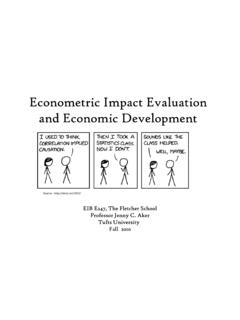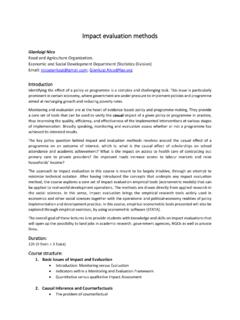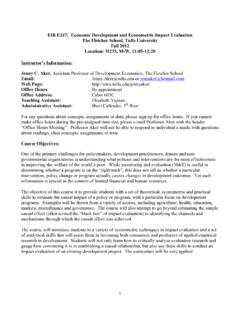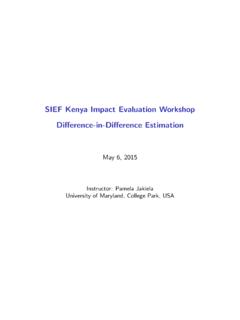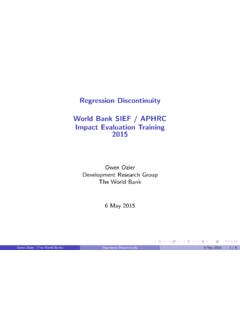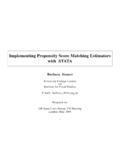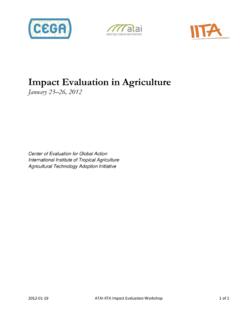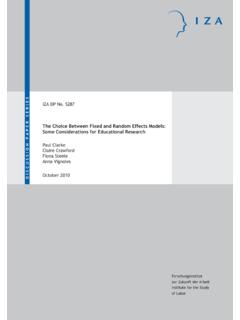Transcription of Empirical Methods - Massachusetts Institute of Technology
1 Empirical Methods MIT Harvard 2390bThe goal of this handout is to present the most common Empirical Methods used in appliedeconomics. Excellent references for the program evaluation and natural experiment approach areAngrist and Krueger (1999), and Mayer (1999). Angrist and Krueger (1999) contains more materialand at a more detailed level than this handout and should be a high priority paper to read forstudents planning to write a thesis in Empirical development, labor of public The evaluation problemEmpirical Methods in development economics, labor economics, and public finance, have beendeveloped to try to answercounterfactualquestions.
2 What would have happened to this person sbehavior if she had been subjected to an alternative policyT( would she work more if marginaltaxes were lower, would she earn less if she had not gone to school, would she be more likely to beimmunized if there had been an immunization center in village?).Here is an example that illustrates the fundamental difficulties of program evaluation :Let us callYTithe average test scores of children in a given schooliif the school has textbooks,andYCithe test scores of children in the same schooliif the school has no textbooks. We areinterested in the differenceYTi YCi, which is the effect of having textbooks for : we will never have a schooliboth with and without books at the same time.
3 What canwe do? We will never know the effect of having textbooks on a school in particular but we mayhope to learn the average effect that it will have on schools:E[YTi YCi]. Handout by Prof. Esther Duflo1 Imagine we have access to data on lots of schools in one region. Some schools have textbooksand others do not. We may think of taking the average in both groups, and the difference betweenaverage test scores in schools with textbooks and average test scores in schools without is equal to:D=E[YTi|School has textbooks] E[YCi|School has no textbooks] =E[YTi|T] E[YCi|C]Subtract and addE[YCi|T], we obtain,D=E[YTi|T] E[YCi|T] E[YCi|C] +E[YCi|T] =E[YTi YCi|T] +E[YCi|T] E[YCi|C]The first termE[YTi YCi|T] is thetreatment effectthat we try to isolate (effect of treatment onthe treated): on average, in the treatment schools, what difference will the books make?
4 The differenceE[YCi|T] E[YCi|C] is the selection bias. It tells us that, beside the effectof the textbooks, there may be systematic differences between schools with textbooks and Methods try to solve this Randomized evaluationsThe ideal set-up to evaluate the effect of a policyXon outcomeYis a randomized reference is Rosenbaum (1995).In a randomized experiment, a sample ofNindividuals is selected from the population (notethat this sample may not be random and may be selected according to observables). This sampleis then dividedrandomlyinto two groups: the Treatment group (NTindividuals) and the Controlgroup (NCindividuals).
5 ObviouslyNT+NC= Treatment group is then treated by policyXwhile the control group is not. Then the outcomeYis observed and compared for both Treatment and Control groups. The effect of policyXismeasured in general by the difference in Empirical means ofYbetween Treatments and Controls: D= E(Y|T) E(Y|C),2where Edenotes the Empirical Treatment has been randomly assigned, the differenceE[YCi|T] E[YCi|C] is equal to 0 (in theabsence of the treatment, schools are the same). Therefore,E[Yi|T] E[Yi|C] =E[YTi YCi|T] =E[YTi YCi],the causal parameter of regression counterpart to obtain standard errors for Dis,Yi= +D 1(i T) + iwhere 1(i T) is a dummy for being in the Treatment The formula for DOLSis simple to handle when there is only one independent variable: DOLS= i1(i T)[Yi Y] i1(i T)[1(i T) NT/N]The denominator is equal to:Den= i1(i T)2 (NT/N) i1(i T) =NT(1 NT/N)The numerator is equal to:Num= i1(i T)[Yi Y] = i1(i T)Yi Y i1(i T)which implies:Num=NT E(Y|T) NT[NT E(Y|T)+NC E(Y|C)]/N=NT(1 NT/N) E(Y|T) (N NT) E(Y|C) =NT(1 NT/N)[ E(Y|T) E(Y|C)].
6 Taking the ratios ofNumandDen, we indeed find that: DOLS= E(Y|T) E(Y|C). Problems of Randomized Experiments1. Cost(a) Financial costsExperiments are very costly and difficult to implement properly in economics. Thenegative income tax experiments of the late 60s and 70s in the US illustrate most of3the issues (see (Pencavel 1986, Ashenfelter and Plant 1990)). As a result they are ofteneither poorly managed, or small, or both (with the corresponding problems we will seebelow).(b) Ethical problemsIt is not possible to run all the experiments we would like to because they might affectsubstantially the economic or social outcomes of the Treated.
7 Alternatively, NGOs orgovernments are reluctant to deprive the controls from treatment which they considerpotentially valuable. Insisting on the fact that it is a productive use of limited resourcesmay be a good way to Threats to internal validity:(a) Non response bias:People may move off during the experiment. If people who leave have particular charac-teristics systematically related to the outcome then there is attrition bias. (cf. Hausmanand Wise (1979) about attrition in the NIT experiment).(b) Mix up of Treatment and Controls:Sometimes, maintaining the allocation to control and treatment to be random is almostimpossible.
8 Example: (Krueger 2000) evaluation of the Tennessee Star small class sizeexperiment: children were moved to small classes (due to parental pressures, bad behav-ior, ). The actual class is therefore not random even though the initial assignmentwas random. It is then important to use theinitial assignmentas the treatment, becauseit is the only variation that was randomly assigned. It can then be used as an instrumentfor actual class size (cf. below).3. Threats to external validity(a) Limited duration:Experiments are in general temporary. People may react differently to a temporaryprogram than to a permanent program.
9 (b) Experiment Specificity:In general, an experiment is run in a particular geographic area ( , the NIT experi-ments). It is not obvious that the same experiment would have given the same results4in another area. Therefore, it is often difficult to generalize the results of an experimentto the total population.(c) Hawthrone and John Henry effects:Treatment and control may behave differently because they know they are being ob-served. Therefore the effects may not be generalized to a context where subjects are notobserved.(d) General Equilibrium effects:Extrapolation complicated because of general equilibrium effects: small scale experi-ments do not generate general equilibrium effects that might be very important whenpolicy is applied to everybody in the Threats to power(a) Small samples:Because experiments are difficult to administer, samples are often small, which makes itdifficult to obtain significant results.
10 It is important to compute power calculation beforestarting an experiment (what is the sample size required to be able to discriminate from0 an effect of a given size?). See the command sampsize in stata. But the crucial inputs(mean and variance of the outcomes before treatment) are often missing, so that thereis always some guess work involved in planning experiments.(b) Experiment design and power of the experiment:When the unit of randomization is a group ( a school), we may need to collect dataon a very large number of individuals to get significant results, if outcomes are stronglycorrelated within groups (see below how standard errors are corrected for the groupedstructure).










